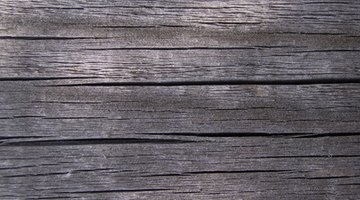How to Use Old Reclaimed Wood With a Planer
Old wood has great character and charm that many wood-workers want to add to their projects. Old barns and other buildings that are being torn down are a source of reclaimed lumber. You can also buy it online from many sources. Wherever you get the reclaimed lumber, you will need to prepare if for use in your projects.

Things You Will Need
- Pry bar
- Trim pry bar
- Hammer
- Wire brush
- Metal detector
- Planer
The do-it-yourself handyman can use reclaimed wood by surfacing it with a planer and a jointer.
-
Disassemble the wood into individual boards. Many times, you will get reclaimed lumber that is nailed together for some old purpose. Use a pry bar and a hammer to dismantle any boards that are nailed together.
-
Wire-brush the surface of the lumber on both sides. This will remove any dirt and debris from the surface of the board that will dull the blades of your planer. It also makes it easier to see any nails or screws that may be broken off below the surface of the lumber.
-
Run a metal detector over the lumber, looking for nails and screws. Often, the reclaimed lumber will have nails or screws that have broken off inside the boards. These are extremely difficult to see on the exterior of the old wood because of age. A metal detector works great for finding any metal that will damage your equipment if not removed. Mark the location of anything found with a marker.
-
Remove any foreign objects from the lumber. For broken-off nails and screws, a trim pry bar works great. The trim pry bar has a small head that you can use to remove the nails or screws. You also often find large, wire staples that the flat edge of the pry bar can slip under for removal. Double-check the board using the metal detector to make sure that you did not miss anything within the lumber.
-
Set the planer's depth to the thickness of the lumber. Run the wood through the planer to remove no more than 1/8 inch of material per pass. Visually inspect the board as it comes out of the planer for anything that may be inside the wood between passes. Repeat this step until the planer has produced a smooth side without any low areas.
-
Flip the board over and repeat the previous step until you have planed the board down to the thickness desired.
Tip
Place the lumber on wood saw horses so that you do not get a false warning from the metal detector.
Warning
Wear gloves when working on old lumber. You do not want to cu yourself on a rusty nail or screw. Wear safety glasses when working with power tools.
References
Tips
- Place the lumber on wood saw horses so that you do not get a false warning from the metal detector.
Warnings
- Wear gloves when working on old lumber. You do not want to cu yourself on a rusty nail or screw.
- Wear safety glasses when working with power tools.
Writer Bio
Jim Wildman served in the United States Marine Corps as a Communication Chief for 10 years. After his tour of duty in Desert Storm he attended Oklahoma State University receiving his Bachelor of Architecture. He worked as an architect for 10 years before starting his own design/build company. He began writing in 2009 for Demand Studios and published on eHow.
Photo Credits
- old wood image by Dzmitry Lameika from Fotolia.com
- old wood image by Dzmitry Lameika from Fotolia.com
More Articles



